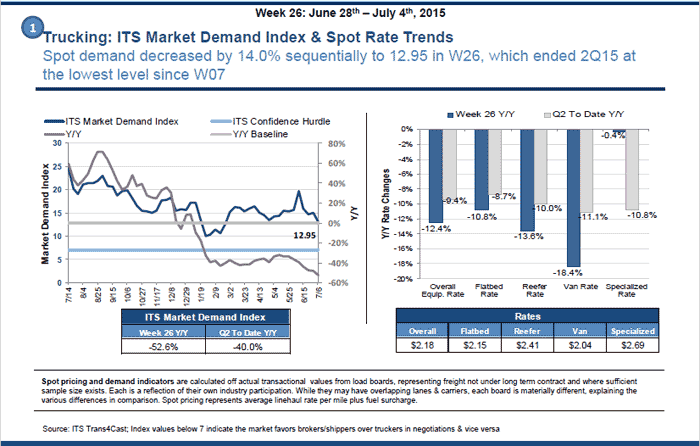Larkin Says: |
 |
| In the rail space it is clear that a reduction in volumes is happening much faster than network’s ability to rightsize their asset base. |
|
What Do You Say?
|
|
|
|
New Expert Insight Column on SCDigest: We have partnered with Stifel Financial Corp. to publish its weekly recap of the week in transportation, written by well-known analyst John Larkin. Check the SCDigest home page each Monday morning for the latest edition.
Takeaways from This Week's Fundamental Research
Week 26 markets the end of 2Q15 and spot market indicators finished with what looks like abysmal numbers, but in reality are fairly normalized and challenged by wild 2014 comparisons.
ATA trucking activity figures and anecdotal commentary we’ve received from our time on the road indicate to us that the truckload contract market has been strong for carriers after having built on capacity shortages seen in 2014.
In the rail space it is clear that a reduction in volumes is happening much faster than network’s ability to rightsize their asset base. We expect rails to show challenged numbers this quarter and then begin to sequentially improve both volumes and asset utilization throughout the remainder of the year.
We currently hold Buy-rated names on five equipment manufacturers/leasing companies [(TRN, $25.48), (RAIL, $21.01), (WNC, $12.27), (ALSN, $29.16), (R, $90.00)], three truckload companies [(SWFT, $23.37), (CGI, $21.28), (KNX, $28.21)], three less-than-truckload companies [(CNW, $36.39), (SAIA, $39.63), (ODFL, $67.68)], one railroad [UNP, $97.82], one short line railroad holding company [GWR, $72.32], one logistics company [XPO, $44.35], and one passenger transport play [STB, $4.48].
Previous Columns by
John Larkin |
|
|
Key Insights from the Analysis of Industry Data Feeds
Trucking & Logistics:
In week 26 (the last week in 2Q15), spot demand was mostly negative. The ITS Market Demand Index (MDI) fell by 14.0% to 12.95 in W26, which ended 2Q15 at the lowest level since W07. Load-to-truck ratios on DAT were mixed for the week as reefer and flatbed increased by 4.3% and 4.9%, respectively, and dry van decreased by 12.6% as it continued a steady decrease from the YTD peak in W22.
DAT spot rates were mixed this week as well. Reefer increased one penny to $2.22 per mile and dry van gained two cents from last week ending at $1.89. Flatbed fell one cent to $2.18 this week. The flatbed and overall equipment ITS Market Rates decreased by 1.4% and 0.9%, respectively this week, while the van rate, specialized rate, and reefer rate increased by 0.5%, 0.7%, and 1.7%, respectively.
Demand (MDI) continues to fall below the 5-year moving average, and 2015 YTD performance is still weak. The latest spot demand (12.95) is about 60.3% lower than last summer’s peak (32.59), but it should be understood that 2014 had extremely inflated comps. For reference, index values below 7.0 indicate the market favors brokers/shippers over truckers in negotiations and vice versa, so the market still remains in pro-carrier territory. To compare further, W26 of 2015 is down 30.0% when compared to the 5-year moving average, yet down an even greater 55.4% when compared to the comparable week in 2014.

Rail:
Total unit volume (i.e., commodity carloads and intermodal units) in W26 were down almost across the board for a total sequential decrease of 2.9% this week. Only UNP showed an increase of 8.6% this week. The worst performers were CP (decreased 9.2%) and the Eastern rails - CSX (decreased 8.7%) and NSC (decreased 6.7%).
Total commodity carloads were also largely negative (5.8% decrease this week). The only rail which showed an increase was BNSF, which increased its commodity carloads only slightly this week by 0.3%. CSX and CP were the weakest performers (down 13.9% and 11.3%, respectively). Intermodal carloads also decreased by 5.2% this week - the only rail with positive intermodal volumes this week was CN, which increased it by 0.9%.
Across Class I’s as a whole 0 intermodal containers, grain mill products, and motor vehicles and equipment were up the most this week y/y. Similarly to the rest of the quarter, most Class I rails have suffered from weak coal volumes, which have persisted for the last several weeks due to regulations and a soft U.S. dollar. This week y/y, notable weaknesses included coal for BNSF, CSX, and NSC. 2Q15 y/y performance for commodity carloads has been weak in general with only a few positive performers including motor vehicles and equipment and intermodal containers. The weakest performers for the quarter included farm products (ex-grain), metals and products, and coal.
Class I Performance metrics were mostly negative this week, and still remain relatively unimpressive. On a weekly sequential basis, velocity mostly decreased - notably KSU (down 4.8%) and CN (down 2.3%). Terminal dwell unfavorably increased by only 0.1%, with weakness from CSX (up 3.3%) and KSU (up 1.8%). The strongest performer was BNSF (down 2.7%). Sequentially this week, the rails have increased their cars on-line by about 0.3%, but decreased them by about 0.7% y/y. In y/y terms, the rails have cut out around 8,600 cars on-line relative to last year. Finally, overall asset efficiency is generally up from last quarter; however, on a total y/y basis more cars on-line have been required to move a like-for-like number of goods.
Any reaction to this week's note? Let us know your thoughts in the Feedback area below.
|